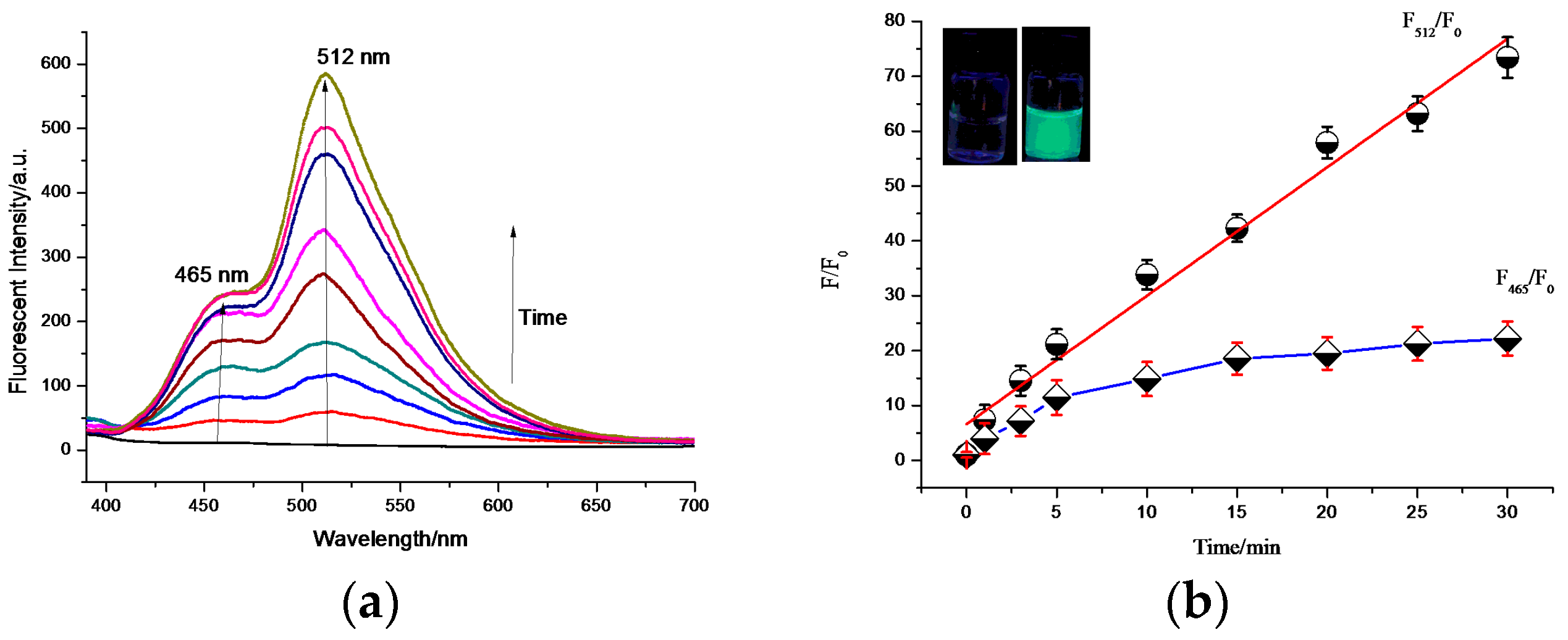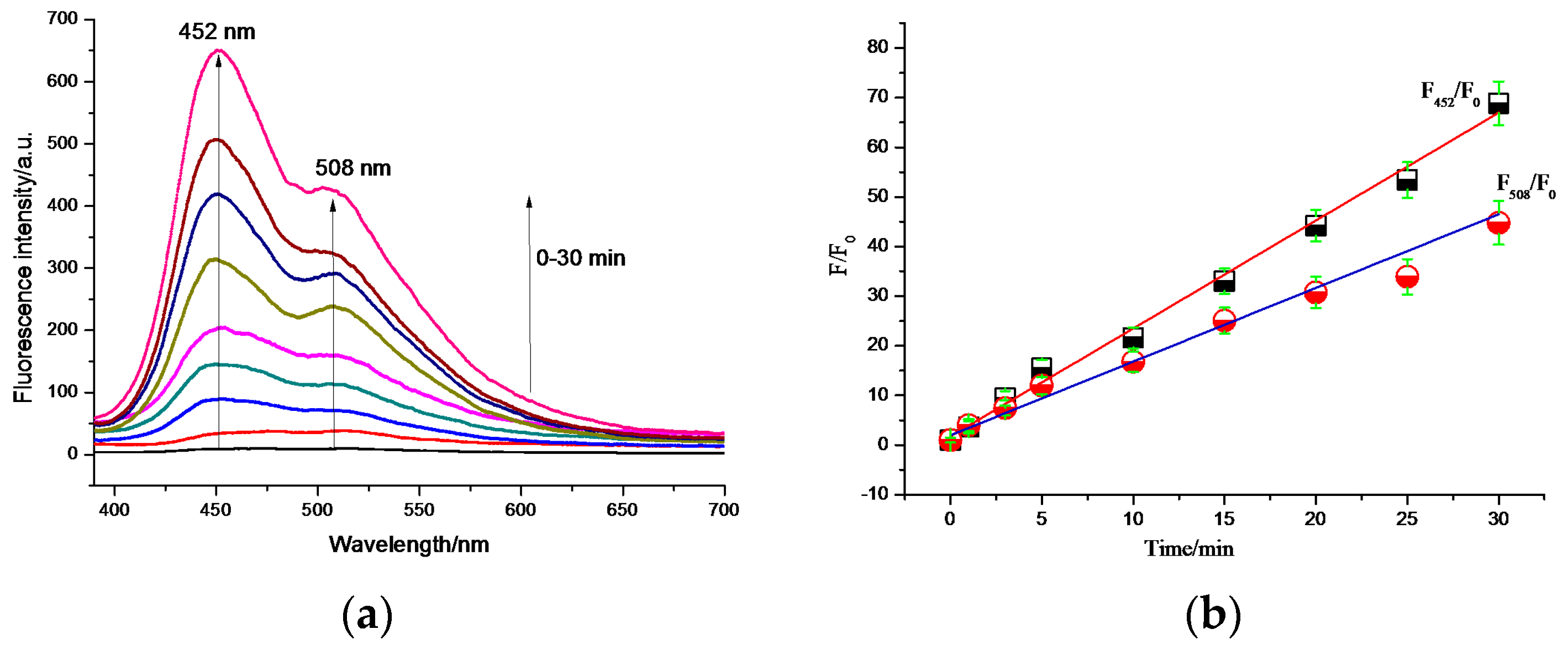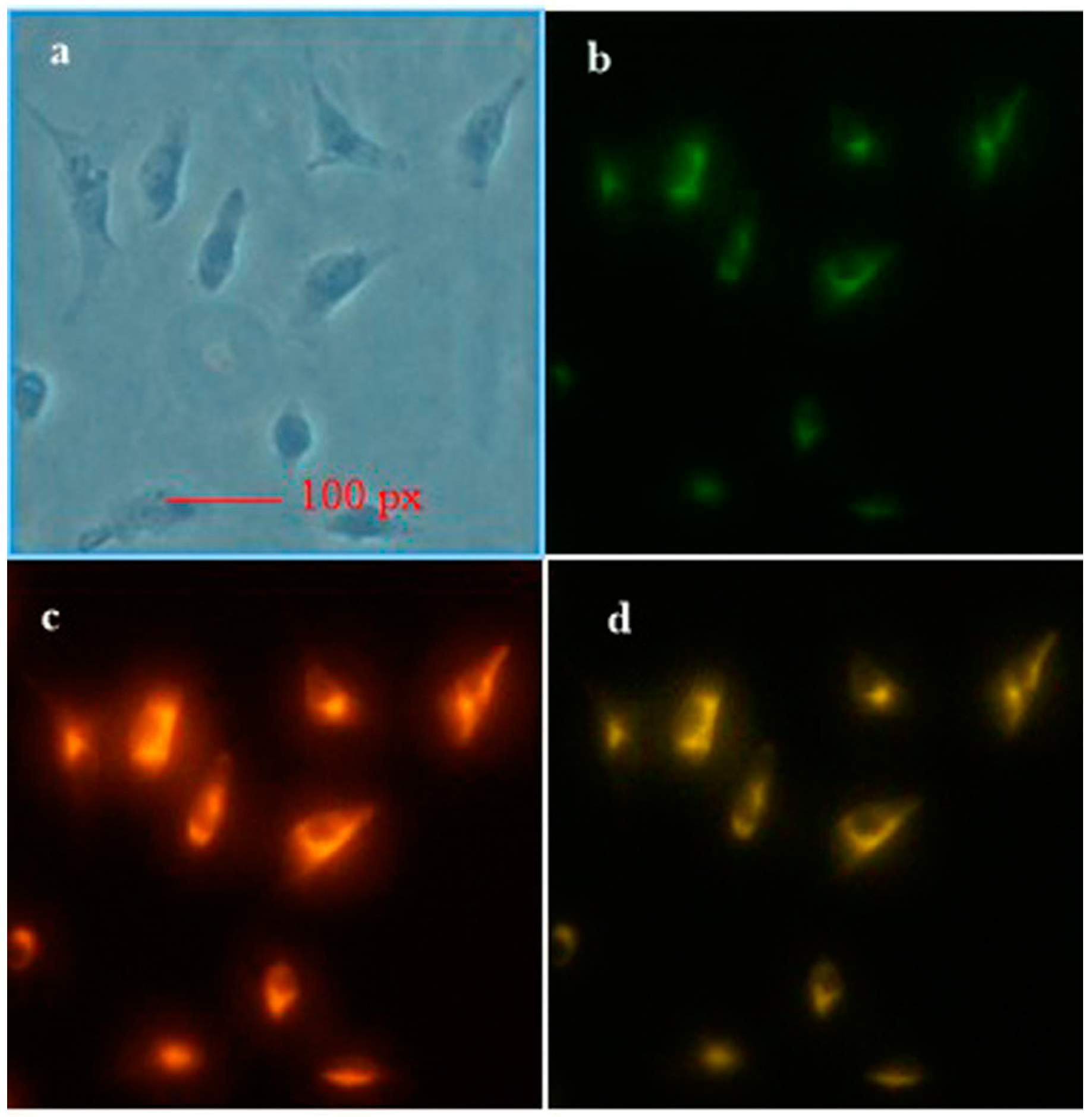ESIPT-Based Photoactivatable Fluorescent Probe for Ratiometric Spatiotemporal Bioimaging
Abstract
:1. Introduction
2. Experimental Section
2.1. Reagents and Apparatus
2.2. Spectroscopic Materials and Methods
2.3. Probe Synthesis
2.4. Cytotoxicity Test
2.5. Bovine Serum Test
2.6. Preparation and Staining of Cell Cultures
3. Results and Discussion
3.1. Design and Synthesis of PHBT
3.2. Photoactivatable Response Property of PHBT
3.3. Bovine Serum Test
3.4. Cell Viability and Imaging in Living MDA-MB-231 Cells
4. Conclusions
Supplementary Materials
Acknowledgments
Author Contributions
Conflicts of Interest
Abbreviations
| PHBT | photoactivatable probe |
| HBT | 2-(2-hydroxyphenyl)benzothiazole |
| ESIPT | excited-state intramolecular proton transfer |
| FPs | fluorescent proteins |
| FRET | fluorescence resonance energy transfer |
| UV | ultraviolet light |
| LC-MS | liquid chromatography-mass spectrometry |
| DMSO | dimethyl sulfoxide |
| PBS | phosphate-buffered saline |
| MTT | 3-(4,5-dimethyl-2-thiazolyl)-2,5-diphenyltetrazolium bromide |
| SDS | sodium dodecyl sulfate |
References
- Bergauer, B.; Knipfer, C.; Amann, A.; Rohde, M.; Tangermann-Gerk, K.; Adler, W.; Schmidt, M.; Nkenke, E.; Stelzle, F. Does laser surgery interfere with optical nerve identification in maxillofacial hard and soft tissue?—An experimental ex vivo study. Sensors 2015, 15, 25416–25432. [Google Scholar] [CrossRef] [PubMed]
- Lim, R.K.V.; Lin, Q. Photoinducible bioorthogonal chemistry: A spatiotemporally controllable tool to visualize and perturb proteins in live cells. Acc. Chem. Res. 2011, 44, 828–839. [Google Scholar] [CrossRef] [PubMed]
- Vaughan, J.C.; Jia, S.; Zhuang, X. Ultrabright photoactivatable fluorophores created by reductive caging. Nat. Methods 2012, 9, 1181–1184. [Google Scholar] [CrossRef] [PubMed]
- Vaillancourt, R.R.; Dhanasekaran, N.; Johnson, G.L.; Ruoho, A.E. 2-Azido-[32P]NAD+, a photoactivatable probe for G-protein structure: Evidence for holotransducin oligomers in which the ADP-ribosylated carboxyl terminus of a interacts with both a and y subunits. Proc. Natl. Acad. Sci. USA 1990, 87, 3645–3649. [Google Scholar] [CrossRef] [PubMed]
- Lee, S.H.; Shin, J.Y.; Lee, A.C. Counting single photoactivatable fluorescent molecules by photoactivated localization microscopy (PALM). Bustamante 2012, 109, 17436–17441. [Google Scholar] [CrossRef] [PubMed]
- Magliery, T.J. Unnatural protein engineering: Producing proteins with unnatural amino acids. Med. Chem. Rev. Online 2005, 2, 303–323. [Google Scholar] [CrossRef]
- Koh, J. Spatial control of protein synthesis. Chem. Biol. 2005, 12, 613–614. [Google Scholar] [CrossRef] [PubMed]
- Manley, S.; Gillette, J.M.; Lippincott-Schwartz, J. Chapter five-single-particle tracking photoactivated localization microscopy for mapping single-molecule dynamics. Methods Enzymol. 2010, 475, 109–120. [Google Scholar] [PubMed]
- Shah, S.; Rangarajan, S.; Friedman, S.H. Light-activated RNA interference. Angew. Chem. 2005, 117, 1352–1356. [Google Scholar] [CrossRef]
- Han, G.; Mokari, T.; Ajo-Franklin, C.; Cohen, B.E. Caged quantum dots. J. Am. Chem. Soc. 2008, 130, 15811–15813. [Google Scholar] [CrossRef] [PubMed]
- Zhang, P.; Han, H. Compact PEGylated polymer-caged quantum dots with improved stability. Colloids Surf. A 2012, 402, 72–79. [Google Scholar] [CrossRef]
- Zhou, L.Y.; Zhang, X.B.; Lv, Y.F.; Yang, C.; Lu, D.Q.; Wu, Y.; Chen, Z.; Liu, Q.L.; Tan, W.H. Localizable and photoactivatable fluorophore for spatiotemporal two-photon bioimaging. Anal. Chem. 2015, 87, 5626–5631. [Google Scholar] [CrossRef] [PubMed]
- Kobayashi, T.; Urano, Y.; Kamiya, M.; Ueno, T.; Kojima, H.; Nagano, T. Highly activatable and rapidly releasable caged fluorescein derivatives. J. Am. Chem. Soc. 2007, 129, 6696–6697. [Google Scholar] [CrossRef] [PubMed]
- Krafft, G.A.; Sutton, W.R.; Cummings, R.T. Photoactivable fluorophores. 3. Synthesis and photoactivation of fluorogenic difunctionalized fluoresceins. J. Am. Chem. Soc. 1988, 110, 301–303. [Google Scholar] [CrossRef]
- Zhao, Y.R.; Zheng, Q.; Dakin, K.; Xu, K.; Martinez, L.M.; Li, W.H. New caged coumarin fluorophores with extraordinary uncaging cross sections suitable for biological imaging applications. J. Am. Chem. Soc. 2004, 126, 4653–4663. [Google Scholar] [CrossRef] [PubMed]
- Gee, K.R.; Weinberg, E.S.; Kozlowski, D.J. Caged Q-rhodamine dextran: A new photoactivated fluorescent tracer. Bioorg. Med. Chem. Lett. 2001, 11, 2181–2183. [Google Scholar] [CrossRef]
- Zheng, G.; Guo, Y.M.; Li, W.H. Photoactivatable and water soluble FRET dyes with high uncaging cross section. J. Am. Chem. Soc. 2007, 129, 10616–10617. [Google Scholar] [CrossRef] [PubMed]
- Raymo, F.M. Photoactivatable synthetic dyes for fluorescence imaging at the nanoscale. J. Phys. Chem. Lett. 2012, 3, 2379–2385. [Google Scholar] [CrossRef] [PubMed]
- Klán, P.; Śolomek, T.; Bochet, C.G.; Blanc, A.; Givens, R.; Rubina, M.; Popik, V.; Kostikov, A.; Wirz, J. Photoremovable protecting groups in chemistry and biology: Reaction mechanisms and efficacy. J. Chem. Rev. 2013, 113, 119–191. [Google Scholar] [CrossRef] [PubMed]
- Raymo, F.M. Photoactivatable synthetic fluorophores. Phys. Chem. Chem. Phys. 2013, 15, 14840–14850. [Google Scholar] [CrossRef] [PubMed]
- Yu, Z.; Ohulchanskyy, T.Y.; An, P.; Prasad, P.N.; Lin, Q. Expansion of bioorthogonal chemistries towards site-specific polymer-protein conjugation. J. Am. Chem. Soc. 2013, 135, 16766–16769. [Google Scholar] [CrossRef] [PubMed]
- Garcia-Amorós, J.S.; Sortino, S.S.; Raymo, F.M. Plasmonic activation of a fluorescent Carbazole–Oxazine switch. Chem. Eur. J. 2014, 20, 10276–10284. [Google Scholar] [CrossRef] [PubMed]
- Kocher, C.; Smitha, P.; Weder, C. Aromatic 2-(2′-hydroxyphenyl)benzoxazole esters: A novel class of caged photoluminescent dyes. J. Mater. Chem. 2002, 12, 2620–2626. [Google Scholar] [CrossRef]
- Majumdar, P.; Zhao, J.Z. 2-(2-hydroxyphenyl)-benzothiazole (HBT)-rhodamine dyad: Acid-switchable absorption and fluorescence of excited-state intramolecular proton transfer (ESIPT). J. Phys. Chem. B 2015, 119, 2384–2394. [Google Scholar] [CrossRef] [PubMed]
- Roohi, H.; Mohtamedifar, N.; Hejazi, F. Intramolecular photoinduced proton transfer in 2-(2′-hydroxyphenyl)benzazole family: A TD-DFT quantum chemical study. Chem. Phys. 2014, 444, 66–76. [Google Scholar] [CrossRef]
- Padalkar, V.S.; Sakamaki, D.; Tohnai, N.; Akutagawa, T.; Sakai, K.; Seki, S. Highly emissive excited-state intramolecular proton transfer (ESIPT) inspired 2-(2′-hydroxy)benzothiazole-fluorene motifs: Spectroscopic and photophysical properties investigation. RSC Adv. 2015, 5, 80283–80296. [Google Scholar] [CrossRef]
- Cohen, B.; Huppert, D.; Solntsev, K.M.; Tsfadia, Y.; Nachliel, E.; Gutman, M. Excited state proton transfer in reverse micelles. J. Am. Chem. Soc. 2002, 124, 7539–7547. [Google Scholar] [CrossRef] [PubMed]
- Corani, A.; Pezzella, A.; Pascher, T.; Gustavsson, T.; Markovitsi, D.; Huijser, A.; Ischia, M.D.; Sundstr, M.V. Excited-state proton-transfer processes of DHICA resolved: From sub-picoseconds to nanoseconds. J. Phys. Chem. Lett. 2013, 4, 1383–1388. [Google Scholar] [CrossRef] [PubMed]
- Ma, J.; Zhao, J.Z.; Yang, P.; Huang, D.D.; Zhang, C.S.; Li, Q.T. New excited state intramolecular proton transfer (ESIPT) dyes based on naphthalimide and observation of long-lived triplet excited states. Chem. Commun. 2012, 48, 9720–9722. [Google Scholar] [CrossRef] [PubMed]
- Yao, D.; Zhao, S.; Guo, J.; Zhang, Z.; Zhang, H.; Liu, Y.; Wang, Y. Hydroxyphenyl-benzothiazole based full color organic emitting materials generated by facile molecular modification. J. Mater. Chem. 2011, 21, 3568–3570. [Google Scholar] [CrossRef]
- Brewer, W.E.; Martinez, M.L.; Chou, P.T. Mechanism of the ground-state reverse proton transfer of 2-(2-hydroxyphenyl) benzothiazole. J. Phys. Chem. 1990, 94, 1915–1918. [Google Scholar] [CrossRef]
- Yang, P.; Zhao, J.Z.; Wu, W.H.; Yu, X.R.; Liu, Y.F. Accessing the long-lived triplet excited states in bodipy-conjugated 2-(2-hydroxyphenyl) benzothiazole/benzoxazoles and applications as organic triplet. J. Org. Chem. 2012, 77, 6166–6178. [Google Scholar] [CrossRef] [PubMed]
- Goswami, S.; Manna, A.; Paul, S.; Maity, A.K.; Saha, P.; Quah, C.K.; Fun, H.K. FRET based ‘red-switch’ for Al3+ over ESIPT based ‘green-switch’ for Zn2+: Dual channel detection with live-cell imaging on a dyad platform. RSC Adv. 2014, 4, 34572–34576. [Google Scholar] [CrossRef]
- Sahana, S.; Mishra, G.; Sivakumar, S.; Bharadwaj, P.K. A 2-(2′-hydroxyphenyl)benzothiazole (HBT)–quinoline conjugate: A highly specific fluorescent probe for Hg(2+) based on ESIPT and its application in bioimaging. Dalton Trans. 2015, 44, 20139–20146. [Google Scholar] [CrossRef] [PubMed]
- Geng, L.H.; Yang, X.F.; Zhong, Y.G.; Li, Z.; Li, H. “Quinone–phenol” transduction activated excited-state intramolecular proton transfer: A new strategy toward ratiometric fluorescent probe for sulfite in living cells. Dyes Pigment 2015, 120, 213–219. [Google Scholar] [CrossRef]
- Singh, R.B.; Mahanta, S.; Kar, S.; Guchhait, N. Photo-physical properties of 1-hydroxy-2-naphthaldehyde: A combined fluorescence spectroscopy and quantum chemical calculations. Chem. Phys. 2007, 331, 373–384. [Google Scholar] [CrossRef]
- Chowdhury, P.; Panja, S.; Chakravorti, S. Excited state prototropic activities in 2-hydroxy 1-naphthaldehyde. J. Phys. Chem. A 2003, 107, 83–90. [Google Scholar] [CrossRef]
- Wu, K.C.; Cheng, Y.M.; Lin, Y.S.; Yeh, Y.S.; Pu, S.C.; Hu, Y.H.; Yu, J.K.; Chou, P.T. Competitive intramolecular hydrogen bonding formation and excited-state proton transfer reaction in 1-[(diethylamino)-methyl]-2-hydroxy-3-naphthaldehyde. Chem. Phys. Lett. 2004, 384, 203–209. [Google Scholar] [CrossRef]
- Mahanta, S.; Singh, R.B.; Kar, S.; Guchhait, N. Excited state intramolecular proton transfer in 3-hydroxy-2-naphthaldehyde: A combined study by absorption and emission spectroscopy and quantum chemical. Chem. Phys. 2006, 324, 742–752. [Google Scholar] [CrossRef]
- Aly, S.M.; Usman, A.; AlZayer, M.; Hamdi, G.A.; Alarousu, E.; Mohammed, O.F. Solvent-dependent excited-state hydrogen transfer and intersystem crossing in 2-(2′-Hydroxyphenyl)-Benzothiazole. J. Phys. Chem. B 2015, 119, 2596–2603. [Google Scholar] [CrossRef] [PubMed]
- Wang, R.J.; Liu, D.; Xu, K.; Li, J.Y. Substituent and solvent effects on excited state intramolecular proton transfer in novel 2-(2′-hydroxyphenyl)benzothiazole derivatives. J. Photochem. Photobiol. 2009, 205, 61–69. [Google Scholar] [CrossRef]
- Chang, S.M.; Hsueh, K.L.; Huang, B.K.; Wu, J.H.; Liao, C.C.; Lin, K.C. Solvent effect of excited state intramolecular proton transfer in 2-(2′-hydroxyphenyl)benzothiazole upon luminescent properties. Surf. Coat. Technol. 2006, 200, 3278–3282. [Google Scholar] [CrossRef]
- Abou-Zied, O.K. Spectroscopy of hydroxyphenyl benzazoles in solution and human serum albumin: Detecting flexibility, specificity and high affinity of the warfarin drug binding site. RSC Adv. 2013, 3, 8747–8755. [Google Scholar] [CrossRef]




© 2016 by the authors; licensee MDPI, Basel, Switzerland. This article is an open access article distributed under the terms and conditions of the Creative Commons Attribution (CC-BY) license (http://creativecommons.org/licenses/by/4.0/).
Share and Cite
Zhou, X.; Jiang, Y.; Zhao, X.; Guo, D. ESIPT-Based Photoactivatable Fluorescent Probe for Ratiometric Spatiotemporal Bioimaging. Sensors 2016, 16, 1684. https://doi.org/10.3390/s16101684
Zhou X, Jiang Y, Zhao X, Guo D. ESIPT-Based Photoactivatable Fluorescent Probe for Ratiometric Spatiotemporal Bioimaging. Sensors. 2016; 16(10):1684. https://doi.org/10.3390/s16101684
Chicago/Turabian StyleZhou, Xiaohong, Yuren Jiang, Xiongjie Zhao, and Dong Guo. 2016. "ESIPT-Based Photoactivatable Fluorescent Probe for Ratiometric Spatiotemporal Bioimaging" Sensors 16, no. 10: 1684. https://doi.org/10.3390/s16101684




